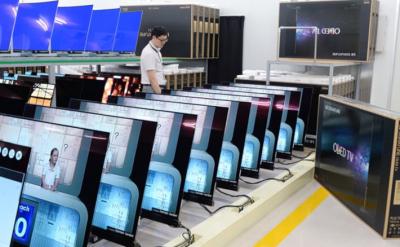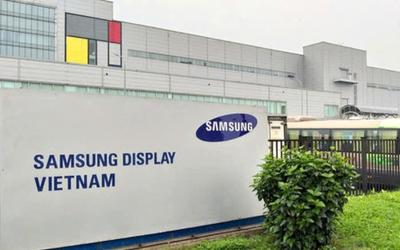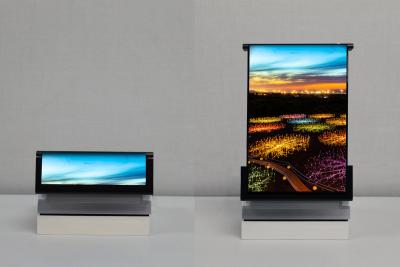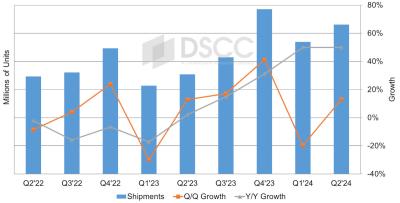OLED TVs - is there a path towards increased production capacity?
OLED TVs offer excellent image quality, outperforming LCDs with superb contrast, excellent and vivid color reproduction and fast refresh rates. In addition, OLEDs enable thin and efficient TVs. OLED TV production has been increasing up until a year ago, reaching a potential capacity of around 10 million units. This is impressive, but considering the entire global TV market that amounts to around 250 million units, OLEDs represent only around 2.5% of the total market (it is important to note that OLEDs tend to be produced in large sizes and carry a much higher average selling price compared to LCDs).
But OLED TV production capacity growth has declined in recent years. In this article we will shortly detail the history of OLED TV production, and look at potential paths towards increased penetration in the future. More details and into the future of OLED technologies and OLED TVs is included in the OLED Toolbox.
A bit of history: in 2013, both Samsung and LGD started producing OLED TV panels. Samsung chose the straightforward RGB side-by-side architecture, in which there are three sub-pixels, with red, green and blue OLED emitters. LG chose its own WRGB (or WOLED) architecture (the IP was acquired from Kodak in 2009) which uses four white OLED subpixels (made from yellow and blue OLED subpixels). Both companies released 55" FHD OLED TVs, priced at over $10,000 per unit. It soon became clear that Samsung's approach was not scalable, while LGD managed to enter mass production quickly and reduce prices dramatically within a few years to compete with the dominant LCD TV technology.
The US is looking into backlisting both BOE and Tianma as it fears that China is taking over the display industry, we look into the implications
The Chairman of the US House Select Committee on the Chinese Communist Party, John Moolenaar, sent a letter to the US Secretary of Defense, saying that the US should place both BOE and Tianna on the DoD 1260H blacklist as Chinese military companies.
In his letter, Mr. Moolenaar says that by using government support, the Chinese has taken over the display industry, and are already leading both the LCD and OLED markets (which is indeed mostly true). As these two companies have close ties to the Chinese government and military, this, according to the letter, poses a big risk to US and its allies.
Samsung Display to invest $1.8 billion in a new OLED module production line in Vietnam
Samsung Display has decided to build a new OLED module production line in Vietnam, mostly to produce automotive OLED modules and IT OLED modules.
The new production line will be built in Yen Phong industrial park in Bac Ninh province east of Hanoi, close to an existing Samsung Electronics plant. It is understood that the Vietnamese government will provide support for Samsung's new line, which will cost a total of around $1.8 billion.
Reports suggest Samsung is accelerating its rollable smartphone project, aiming to launch it in 2025
According to a report from Korea, Samsung is progressing with its rollable OLED development project, and the company aims to launch its first rollable smartphone in 2025. When fully opened, the phone will sport a very large 12.4" display. Interestingly, Samsung apparently will implement an under-the-display camera solution.
Samsung's acceleration of its rollable phone project is seen as the Korean device maker's response to Huawei's tri-folding smartphone, the Mate XT. It is seen that this was an embarrassment for Samsung, that recently also to witness LG Display's leading over it with tandem OLED production. It will remain to be seen whether Samsung's acceleration will lead to problems in quality and reliability - which happened when it launched the world's first foldable phone back in 2019.
Apple looks to adopt a TFT AMOLED for its future entry-level MR headset
There's an interesting report in Korea that claims that Apple is developing an entry-level MR headset, and is looking to adopt TFT based AMOLED displays, as opposed to the currently-used OLED microdisplays. It is reported that both JDI and Samsung are in talks with Apple, and have been requested to develop lower-cost TFT AMOLEDs with a pixel density of 1,500 PPI (down from 3,400 PPI high-end Sony microdisplays used in the Vision Pro).
It is understood that JDI has already developed the technology and produced 1,500 PPI samples for Apple. Interestingly it is reported that the JDI displays uses Sony's technology, although it is not stated which technology exactly. Samsung meanwhile is also developing 1,500 PPI AMOLEDs at its A2 fab. Apple's target is to release the headset at around 2026-2027 and by then it is likely that more OLED producers (such as LG Display) will develop similar displays.
UBI Research: OLED tablet shipments to jump over 500% in 2024 to reach 12 million units
UBI Research estimates that 12 million OLED tablet panels will ship in 2024, and increase of over 500% from 2023 (1.84 million units), following Apple's adoption of OLEDs in its iPad Pro devices for the first time.
UBI sees the tablet OLED display market continuing to grow, and is expected to reach 30 million units in 2028. The current market leaders are Samsung Display and LG Display, but other display makers are also targeting this market, with BOE aiming to ship 1.5 million OLED tablet panels in 2024, and Visionox around 800,000 units.
Samsung Display plans to adopt new technologies with an aim to cut the power consumption of OLEDs by over 50%
During iMID 2024, Samsung Display's eVP Yi Chung said that the company plans to reduce the power consumption of its OLED panels by over 50%. SDC is developing several technologies, each contributing to the same efficiency goal.
SDC did not detail its plans exactly, but it did mention some of the new technologies it is working on - polarizer-free OLEDs (these have been commercialized already), multi-frequency driving (demonstrated by other OLED makers), tandem OLED architecture and the adoption of high efficiency blue PHOLED emitters.
Meta reportedly cancels its plans to release a high-end VR headset
According to reports, Meta has decided to cancel one of its VR projects that was planned for 2027. This device was to be a high-end product, similar to Apple's Vision Pro - with a similar high price tag. Following the poor market reaction for Apple's Vision Pro, Meta decided to scrap the project.

The original Oculus Rift
Meta was planning to use OLED microdisplays in its upcoming high-end headset, as these are the best performing displays for such products. It is reported that one of the reasons that Meta is not proceeding with its project is the high price of the OLEDs. These are expensive displays indeed - according to some estimates, Apple is paying $350 for each display, which means around $700 for each headset. On the other hand, it is estimated that OLED microdisplay prices are set to drop sharply in the near future as new capacity comes online, and new players (including Samsung and LGD) start producing displays.
DSCC: OLED panel shipments jumps 50% in Q2 2024
According to DSCC, OLED panel shipments increased 50% in the second quarter of 2024, compared to the second quarter of 2023. Compared to the previous quarter, shipments increased 13%.
DSCC says that OLED tablet shipments increased 356% in the quarter compared to last year (led by Apple's adoption of AMOLEDs in its iPad Pro devices). OLED smartphone spanel shipments also 49%, while OLED TV panel shipments increased 30% from 2023.
Samsung shows a 1.3" 12,000 nits OLED microdisplay at K-Display 2024
Samsung Display demonstrated a new OLED microdisplay at K-Display 2024, a 1.3" 12,000 nits 4000 PPI display. It is not clear whether this display is a direct-emission display, or one that uses white OLEDs with color filters.
Samsung Display's CEO, Choi Joo-seon, said during the conference that SDC will soon commercialize OLED microdisplays based on eMagin's direct-patterning deposition technology (SDC acquired eMagin in 2023). Choi says that the price of OLED microdisplays is an important differentiating factor. Last week Omdia estimated that the price of OLED microdisplays is set to decline sharply in the near future.
Pagination
- Previous page
- Page 2
- Next page









